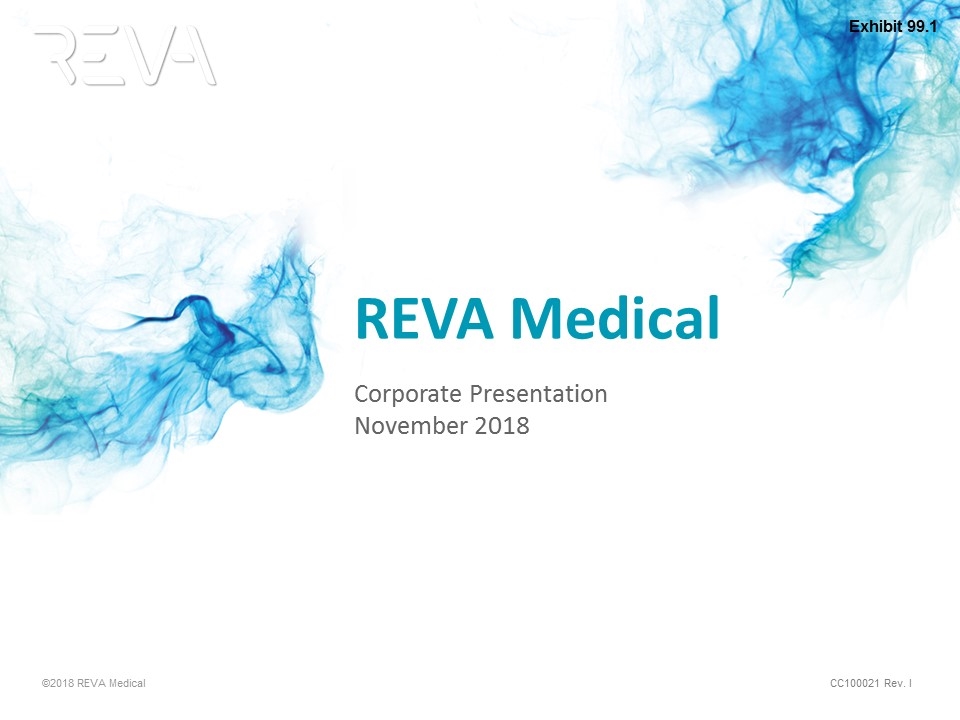
REVA Medical Corporate Presentation November 2018 ©2018 REVA Medical CC100021 Rev. I Exhibit 99.1
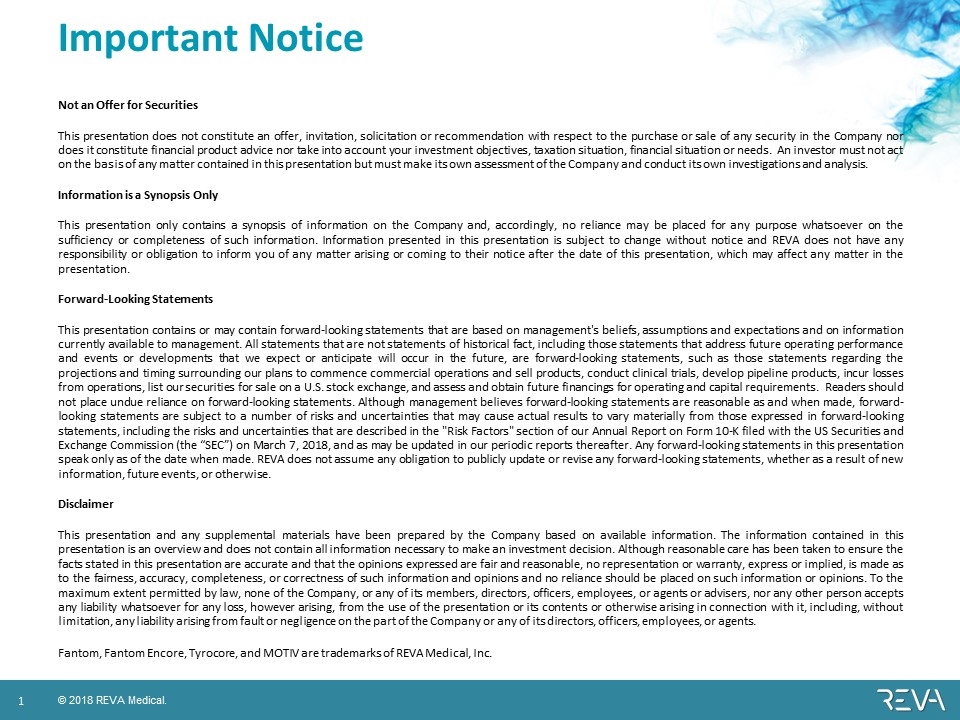
Important Notice Not an Offer for Securities This presentation does not constitute an offer, invitation, solicitation or recommendation with respect to the purchase or sale of any security in the Company nor does it constitute financial product advice nor take into account your investment objectives, taxation situation, financial situation or needs. An investor must not act on the basis of any matter contained in this presentation but must make its own assessment of the Company and conduct its own investigations and analysis. Information is a Synopsis Only This presentation only contains a synopsis of information on the Company and, accordingly, no reliance may be placed for any purpose whatsoever on the sufficiency or completeness of such information. Information presented in this presentation is subject to change without notice and REVA does not have any responsibility or obligation to inform you of any matter arising or coming to their notice after the date of this presentation, which may affect any matter in the presentation. Forward-Looking Statements This presentation contains or may contain forward-looking statements that are based on management's beliefs, assumptions and expectations and on information currently available to management. All statements that are not statements of historical fact, including those statements that address future operating performance and events or developments that we expect or anticipate will occur in the future, are forward-looking statements, such as those statements regarding the projections and timing surrounding our plans to commence commercial operations and sell products, conduct clinical trials, develop pipeline products, incur losses from operations, list our securities for sale on a U.S. stock exchange, and assess and obtain future financings for operating and capital requirements. Readers should not place undue reliance on forward-looking statements. Although management believes forward-looking statements are reasonable as and when made, forward-looking statements are subject to a number of risks and uncertainties that may cause actual results to vary materially from those expressed in forward-looking statements, including the risks and uncertainties that are described in the "Risk Factors" section of our Annual Report on Form 10-K filed with the US Securities and Exchange Commission (the “SEC”) on March 7, 2018, and as may be updated in our periodic reports thereafter. Any forward-looking statements in this presentation speak only as of the date when made. REVA does not assume any obligation to publicly update or revise any forward-looking statements, whether as a result of new information, future events, or otherwise. Disclaimer This presentation and any supplemental materials have been prepared by the Company based on available information. The information contained in this presentation is an overview and does not contain all information necessary to make an investment decision. Although reasonable care has been taken to ensure the facts stated in this presentation are accurate and that the opinions expressed are fair and reasonable, no representation or warranty, express or implied, is made as to the fairness, accuracy, completeness, or correctness of such information and opinions and no reliance should be placed on such information or opinions. To the maximum extent permitted by law, none of the Company, or any of its members, directors, officers, employees, or agents or advisers, nor any other person accepts any liability whatsoever for any loss, however arising, from the use of the presentation or its contents or otherwise arising in connection with it, including, without limitation, any liability arising from fault or negligence on the part of the Company or any of its directors, officers, employees, or agents. Fantom, Fantom Encore, Tyrocore, and MOTIV are trademarks of REVA Medical, Inc.
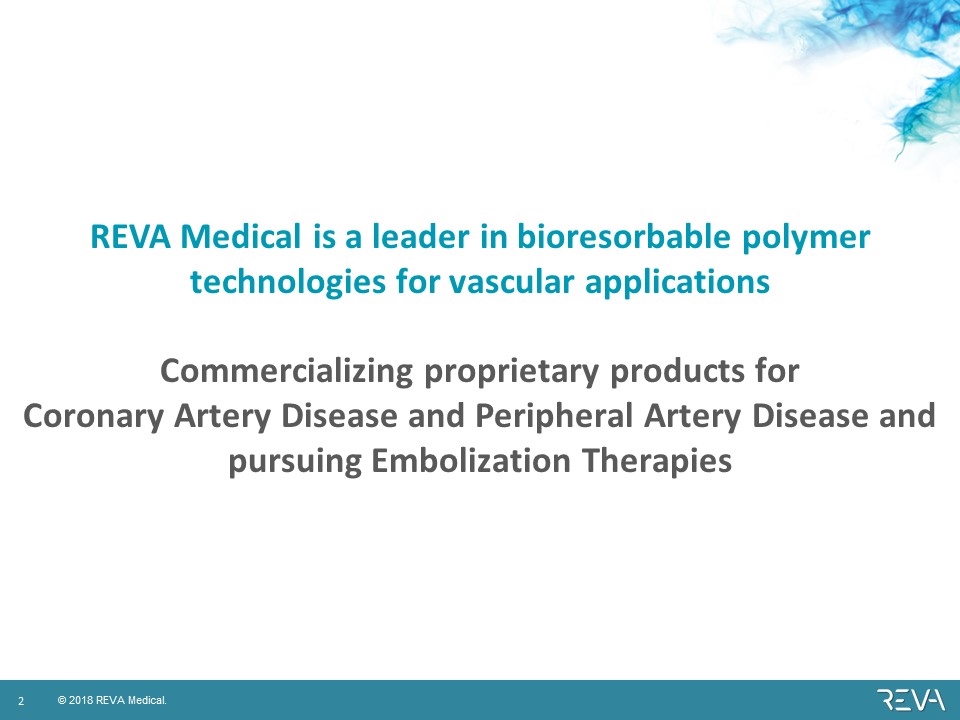
REVA Medical is a leader in bioresorbable polymer technologies for vascular applications Commercializing proprietary products for Coronary Artery Disease and Peripheral Artery Disease and pursuing Embolization Therapies
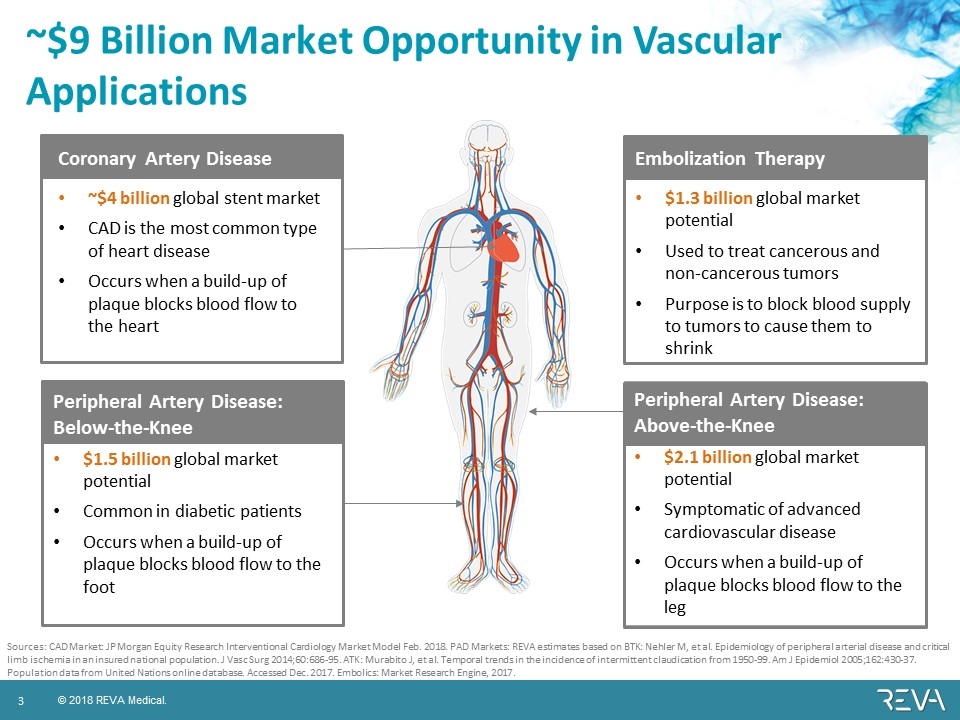
~$9 Billion Market Opportunity in Vascular Applications Coronary Artery Disease ~$4 billion global stent market CAD is the most common type of heart disease Occurs when a build-up of plaque blocks blood flow to the heart Peripheral Artery Disease: Below-the-Knee $1.5 billion global market potential Common in diabetic patients Occurs when a build-up of plaque blocks blood flow to the foot Peripheral Artery Disease: Above-the-Knee $2.1 billion global market potential Symptomatic of advanced cardiovascular disease Occurs when a build-up of plaque blocks blood flow to the leg Embolization Therapy $1.3 billion global market potential Used to treat cancerous and non-cancerous tumors Purpose is to block blood supply to tumors to cause them to shrink Sources: CAD Market: JP Morgan Equity Research Interventional Cardiology Market Model Feb. 2018. PAD Markets: REVA estimates based on BTK: Nehler M, et al. Epidemiology of peripheral arterial disease and critical limb ischemia in an insured national population. J Vasc Surg 2014;60:686-95. ATK: Murabito J, et al. Temporal trends in the incidence of intermittent claudication from 1950-99. Am J Epidemiol 2005;162:430-37. Population data from United Nations online database. Accessed Dec. 2017. Embolics: Market Research Engine, 2017.
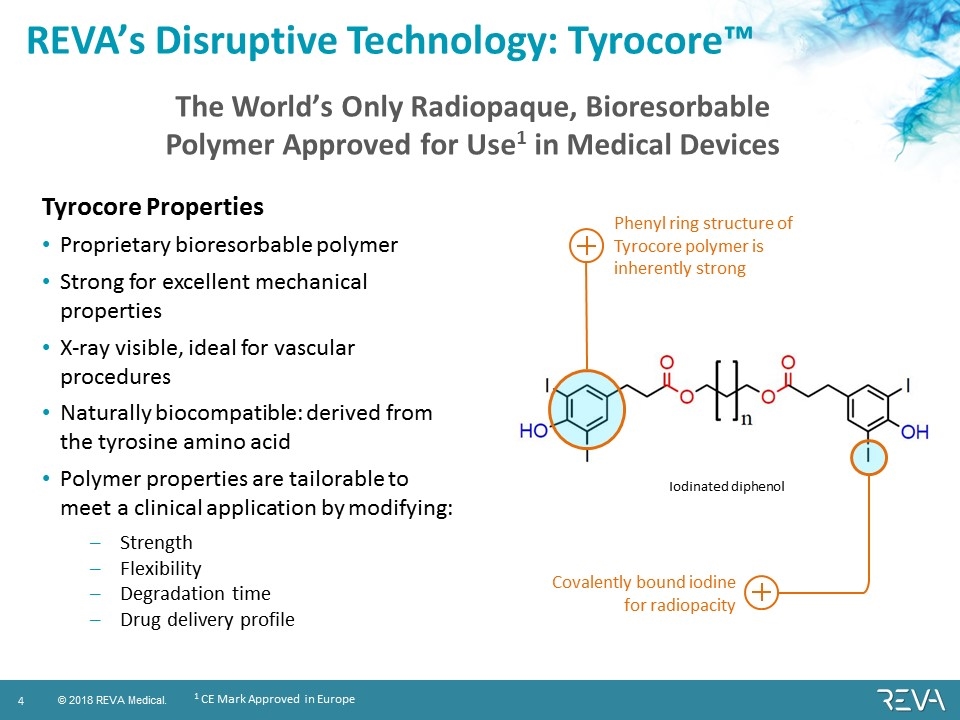
REVA’s Disruptive Technology: Tyrocore™ Tyrocore Properties Proprietary bioresorbable polymer Strong for excellent mechanical properties X-ray visible, ideal for vascular procedures Naturally biocompatible: derived from the tyrosine amino acid Polymer properties are tailorable to meet a clinical application by modifying: Strength Flexibility Degradation time Drug delivery profile The World’s Only Radiopaque, Bioresorbable Polymer Approved for Use1 in Medical Devices Iodinated diphenol Covalently bound iodine for radiopacity Phenyl ring structure of Tyrocore polymer is inherently strong 1 CE Mark Approved in Europe
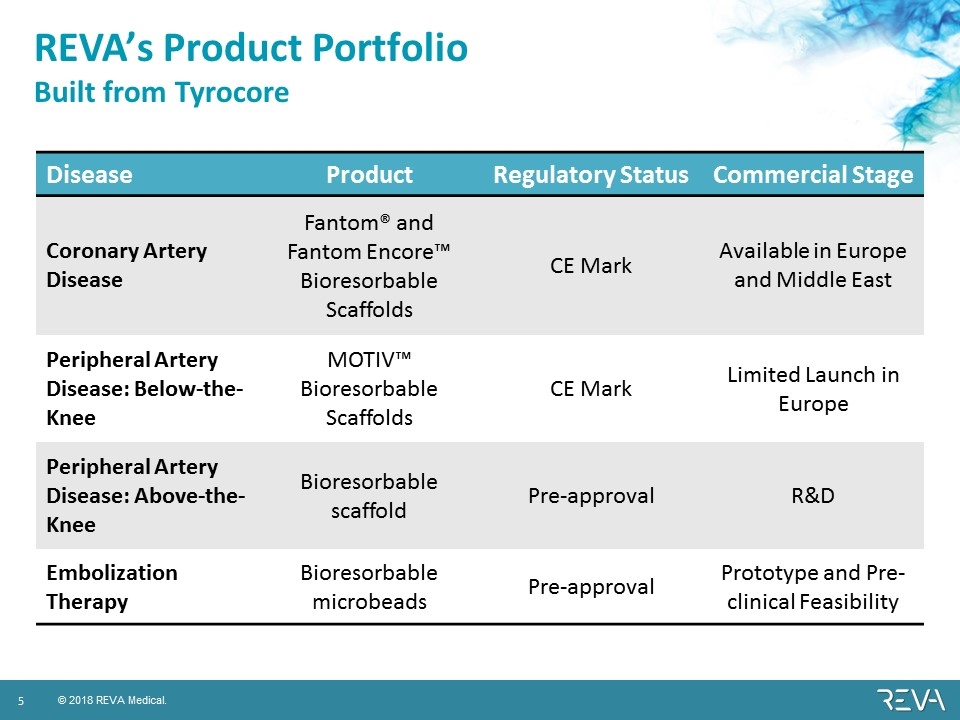
REVA’s Product Portfolio Built from Tyrocore Disease Product Regulatory Status Commercial Stage Coronary Artery Disease Fantom® and Fantom Encore™ Bioresorbable Scaffolds CE Mark Available in Europe and Middle East Peripheral Artery Disease: Below-the-Knee MOTIV™ Bioresorbable Scaffolds CE Mark Limited Launch in Europe Peripheral Artery Disease: Above-the-Knee Bioresorbable scaffold Pre-approval R&D Embolization Therapy Bioresorbable microbeads Pre-approval Prototype and Pre-clinical Feasibility
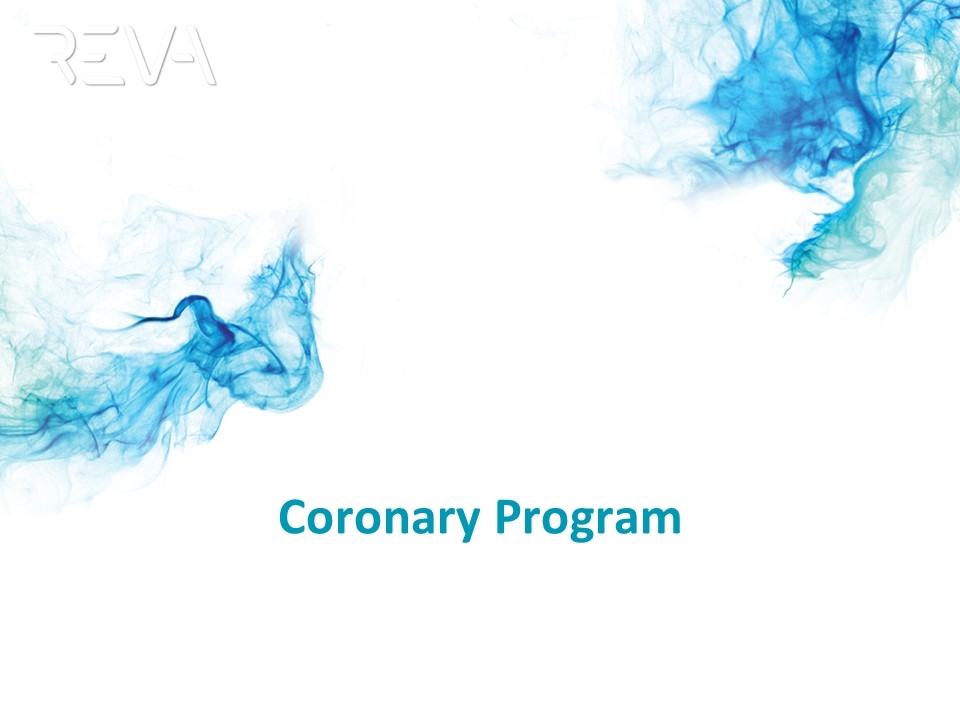
Coronary Program
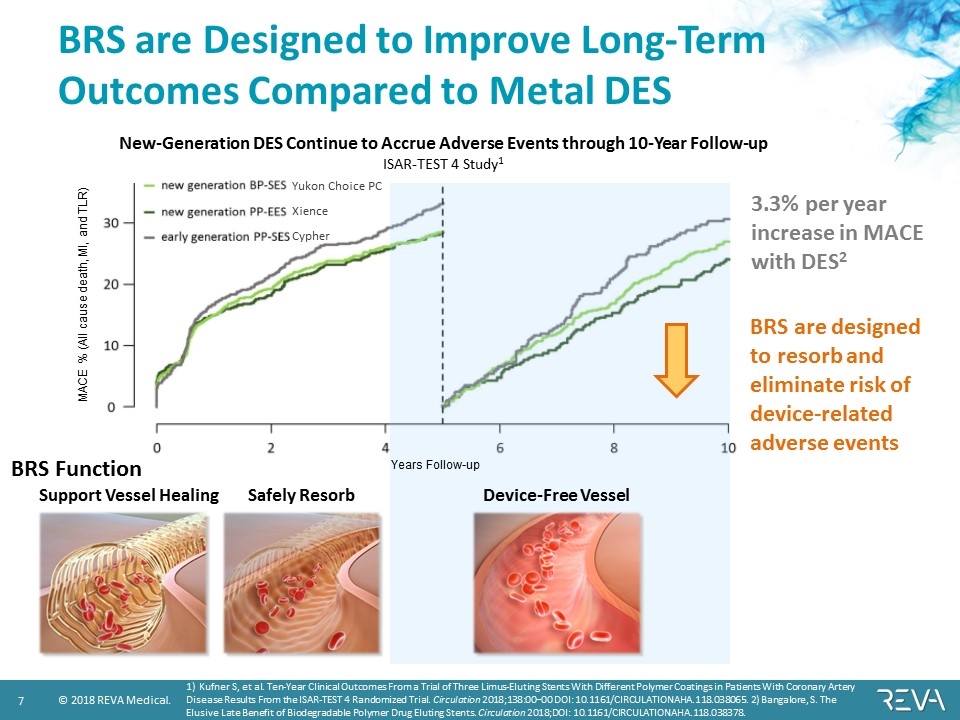
BRS are Designed to Improve Long-Term Outcomes Compared to Metal DES Support Vessel Healing Safely Resorb Device-Free Vessel 3.3% per year increase in MACE with DES2 BRS are designed to resorb and eliminate risk of device-related adverse events New-Generation DES Continue to Accrue Adverse Events through 10-Year Follow-up ISAR-TEST 4 Study1 BRS Function 1) Kufner S, et al. Ten-Year Clinical Outcomes From a Trial of Three Limus-Eluting Stents With Different Polymer Coatings in Patients With Coronary Artery Disease Results From the ISAR-TEST 4 Randomized Trial. Circulation 2018;138:00–00 DOI: 10.1161/CIRCULATIONAHA.118.038065. 2) Bangalore, S. The Elusive Late Benefit of Biodegradable Polymer Drug Eluting Stents. Circulation 2018;DOI: 10.1161/CIRCULATIONAHA.118.038378. Xience Cypher Yukon Choice PC MACE % (All cause death, MI, and TLR) Years Follow-up
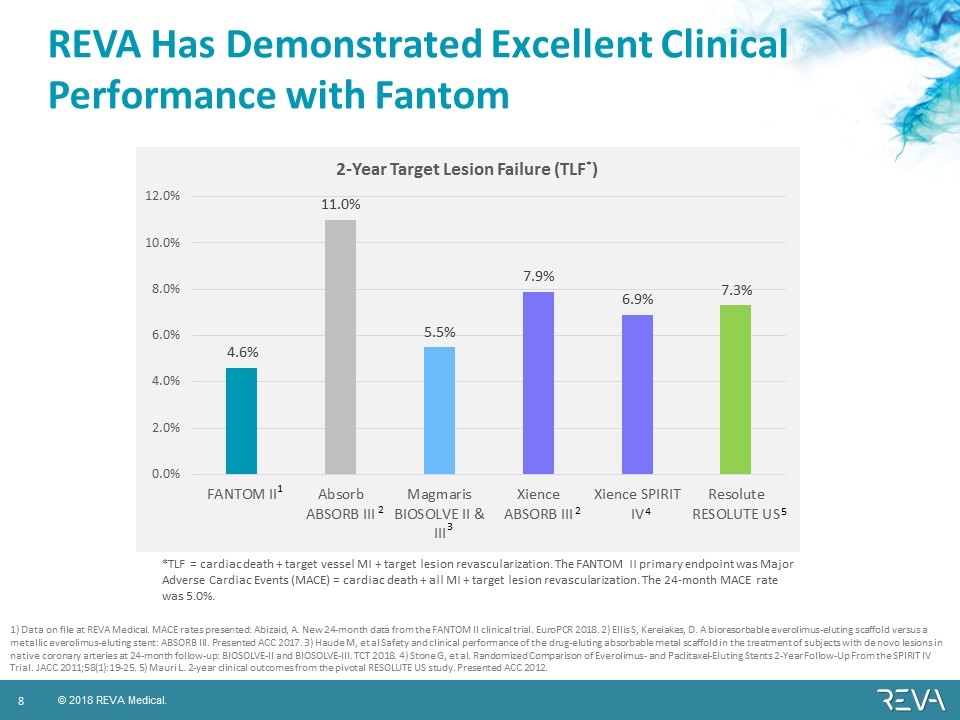
REVA Has Demonstrated Excellent Clinical Performance with Fantom 1) Data on file at REVA Medical. MACE rates presented: Abizaid, A. New 24-month data from the FANTOM II clinical trial. EuroPCR 2018. 2) Ellis S, Kereiakes, D. A bioresorbable everolimus-eluting scaffold versus a metallic everolimus-eluting stent: ABSORB III. Presented ACC 2017. 3) Haude M, et al Safety and clinical performance of the drug-eluting absorbable metal scaffold in the treatment of subjects with de novo lesions in native coronary arteries at 24-month follow-up: BIOSOLVE-II and BIOSOLVE-III. TCT 2018. 4) Stone G, et al. Randomized Comparison of Everolimus- and Paclitaxel-Eluting Stents 2-Year Follow-Up From the SPIRIT IV Trial. JACC 2011;58(1):19-25. 5) Mauri L. 2-year clinical outcomes from the pivotal RESOLUTE US study. Presented ACC 2012. *TLF = cardiac death + target vessel MI + target lesion revascularization. The FANTOM II primary endpoint was Major Adverse Cardiac Events (MACE) = cardiac death + all MI + target lesion revascularization. The 24-month MACE rate was 5.0%. 1 2 2 3 4 5
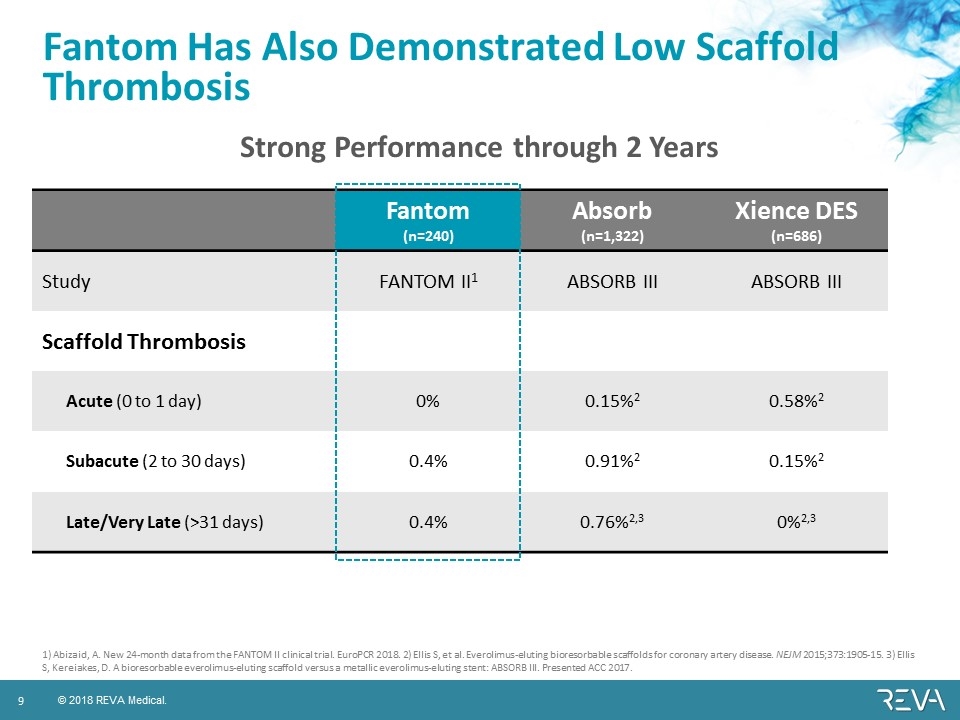
Fantom Has Also Demonstrated Low Scaffold Thrombosis Fantom (n=240) Absorb (n=1,322) Xience DES (n=686) Study FANTOM II1 ABSORB III ABSORB III Scaffold Thrombosis Acute (0 to 1 day) 0% 0.15%2 0.58%2 Subacute (2 to 30 days) 0.4% 0.91%2 0.15%2 Late/Very Late (>31 days) 0.4% 0.76%2,3 0%2,3 1) Abizaid, A. New 24-month data from the FANTOM II clinical trial. EuroPCR 2018. 2) Ellis S, et al. Everolimus-eluting bioresorbable scaffolds for coronary artery disease. NEJM 2015;373:1905-15. 3) Ellis S, Kereiakes, D. A bioresorbable everolimus-eluting scaffold versus a metallic everolimus-eluting stent: ABSORB III. Presented ACC 2017. Strong Performance through 2 Years
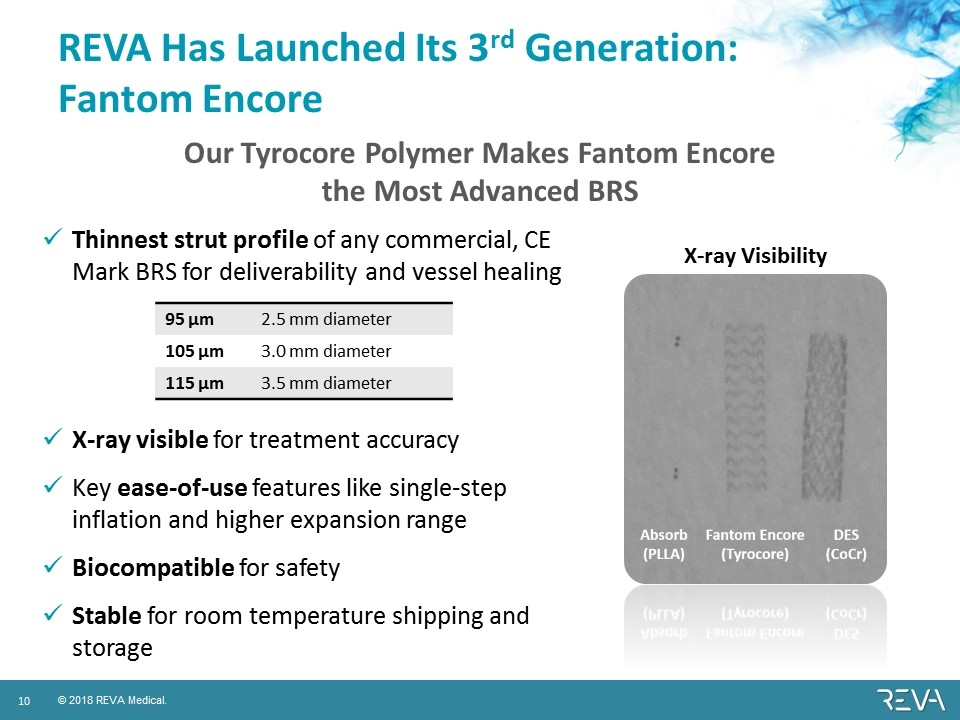
REVA Has Launched Its 3rd Generation: Fantom Encore Our Tyrocore Polymer Makes Fantom Encore the Most Advanced BRS Thinnest strut profile of any commercial, CE Mark BRS for deliverability and vessel healing X-ray visible for treatment accuracy Key ease-of-use features like single-step inflation and higher expansion range Biocompatible for safety Stable for room temperature shipping and storage X-ray Visibility 95 µm 2.5 mm diameter 105 µm 3.0 mm diameter 115 µm 3.5 mm diameter
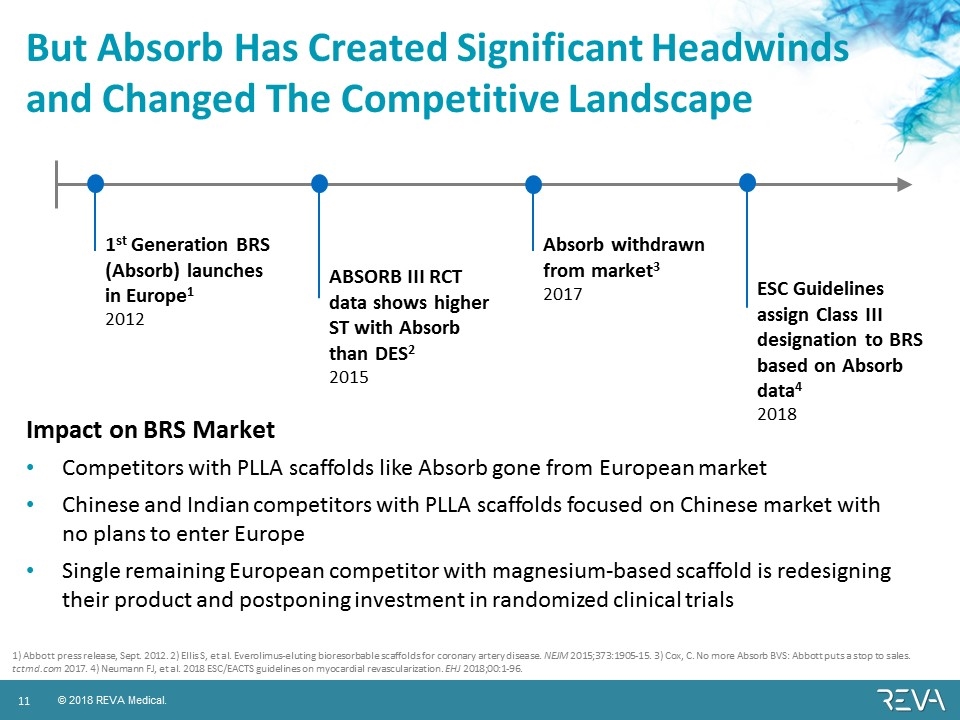
Impact on BRS Market Competitors with PLLA scaffolds like Absorb gone from European market Chinese and Indian competitors with PLLA scaffolds focused on Chinese market with no plans to enter Europe Single remaining European competitor with magnesium-based scaffold is redesigning their product and postponing investment in randomized clinical trials But Absorb Has Created Significant Headwinds and Changed The Competitive Landscape 1st Generation BRS (Absorb) launches in Europe1 2012 Absorb withdrawn from market3 2017 ABSORB III RCT data shows higher ST with Absorb than DES2 2015 ESC Guidelines assign Class III designation to BRS based on Absorb data4 2018 1) Abbott press release, Sept. 2012. 2) Ellis S, et al. Everolimus-eluting bioresorbable scaffolds for coronary artery disease. NEJM 2015;373:1905-15. 3) Cox, C. No more Absorb BVS: Abbott puts a stop to sales. tctmd.com 2017. 4) Neumann FJ, et al. 2018 ESC/EACTS guidelines on myocardial revascularization. EHJ 2018;00:1-96.
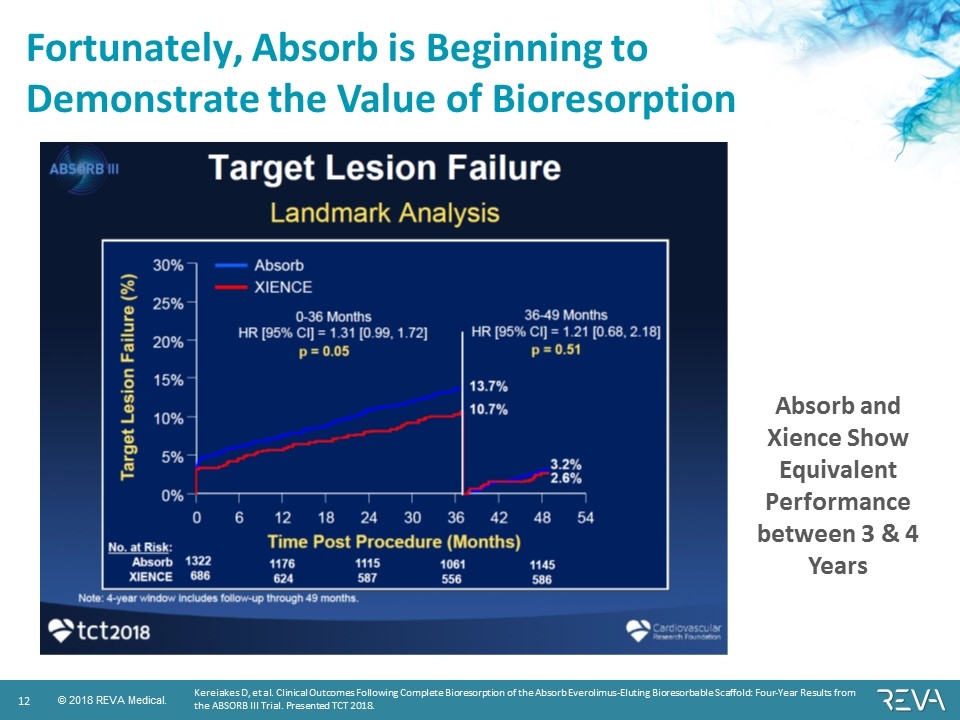
Fortunately, Absorb is Beginning to Demonstrate the Value of Bioresorption Absorb and Xience Show Equivalent Performance between 3 & 4 Years Kereiakes D, et al. Clinical Outcomes Following Complete Bioresorption of the Absorb Everolimus-Eluting Bioresorbable Scaffold: Four-Year Results from the ABSORB III Trial. Presented TCT 2018.
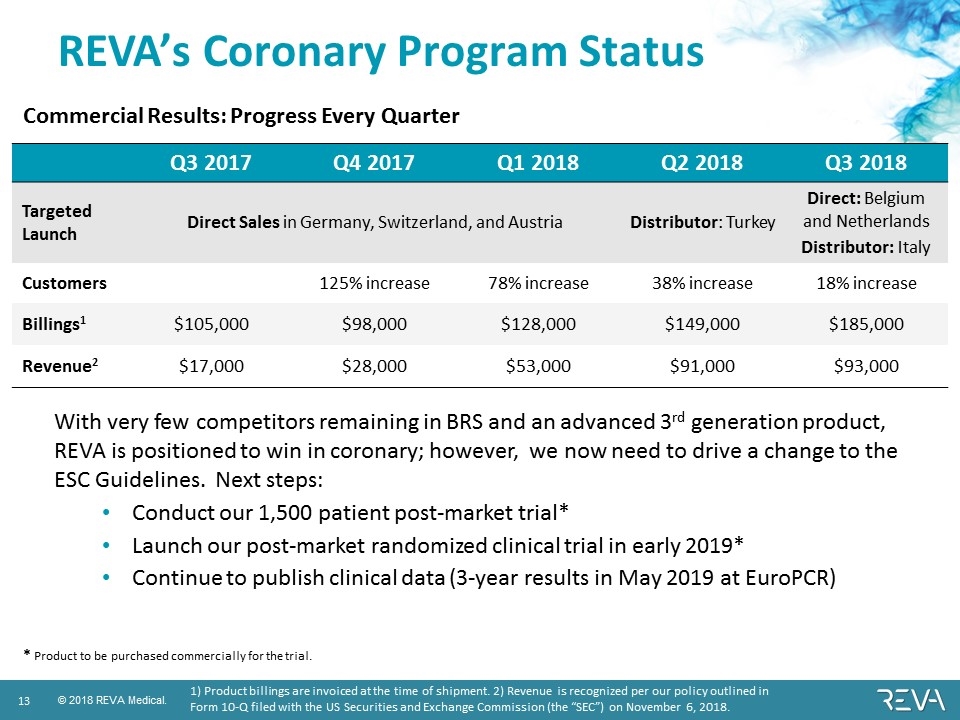
REVA’s Coronary Program Status Q3 2017 Q4 2017 Q1 2018 Q2 2018 Q3 2018 Targeted Launch Direct Sales in Germany, Switzerland, and Austria Distributor: Turkey Direct: Belgium and Netherlands Distributor: Italy Customers 125% increase 78% increase 38% increase 18% increase Billings1 $105,000 $98,000 $128,000 $149,000 $185,000 Revenue2 $17,000 $28,000 $53,000 $91,000 $93,000 Commercial Results: Progress Every Quarter 1) Product billings are invoiced at the time of shipment. 2) Revenue is recognized per our policy outlined in Form 10-Q filed with the US Securities and Exchange Commission (the “SEC”) on November 6, 2018. With very few competitors remaining in BRS and an advanced 3rd generation product, REVA is positioned to win in coronary; however, we now need to drive a change to the ESC Guidelines. Next steps: Conduct our 1,500 patient post-market trial* Launch our post-market randomized clinical trial in early 2019* Continue to publish clinical data (3-year results in May 2019 at EuroPCR) * Product to be purchased commercially for the trial.
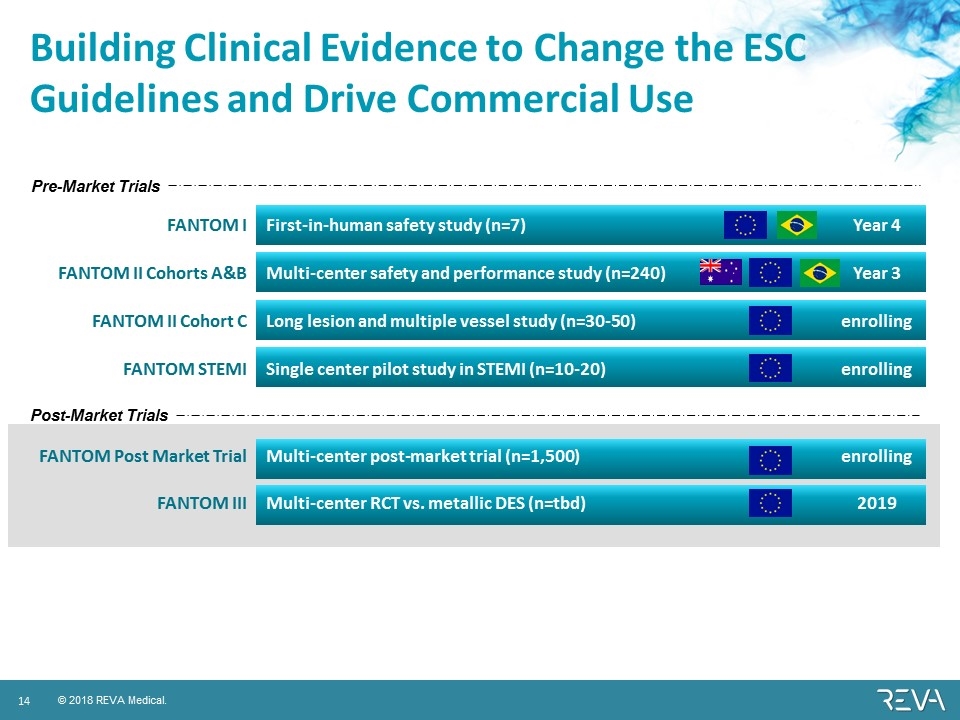
Building Clinical Evidence to Change the ESC Guidelines and Drive Commercial Use FANTOM I First-in-human safety study (n=7) Year 4 FANTOM II Cohorts A&B Multi-center safety and performance study (n=240) Year 3 FANTOM II Cohort C Long lesion and multiple vessel study (n=30-50) enrolling FANTOM STEMI Single center pilot study in STEMI (n=10-20) enrolling FANTOM Post Market Trial Multi-center post-market trial (n=1,500) enrolling FANTOM III Multi-center RCT vs. metallic DES (n=tbd) 2019 Pre-Market Trials Post-Market Trials
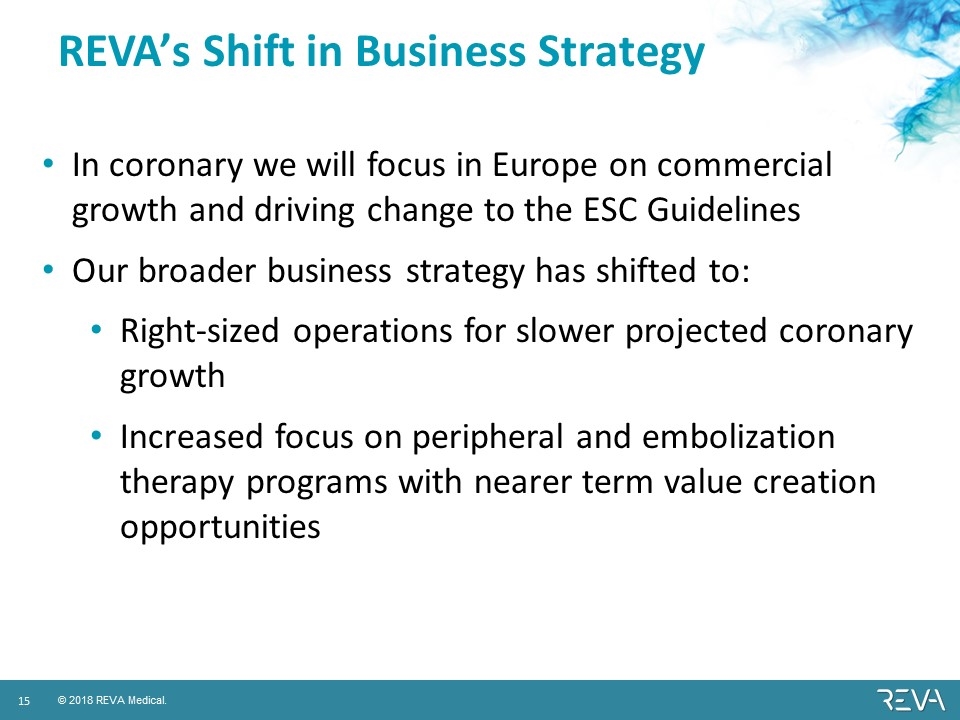
REVA’s Shift in Business Strategy In coronary we will focus in Europe on commercial growth and driving change to the ESC Guidelines Our broader business strategy has shifted to: Right-sized operations for slower projected coronary growth Increased focus on peripheral and embolization therapy programs with nearer term value creation opportunities
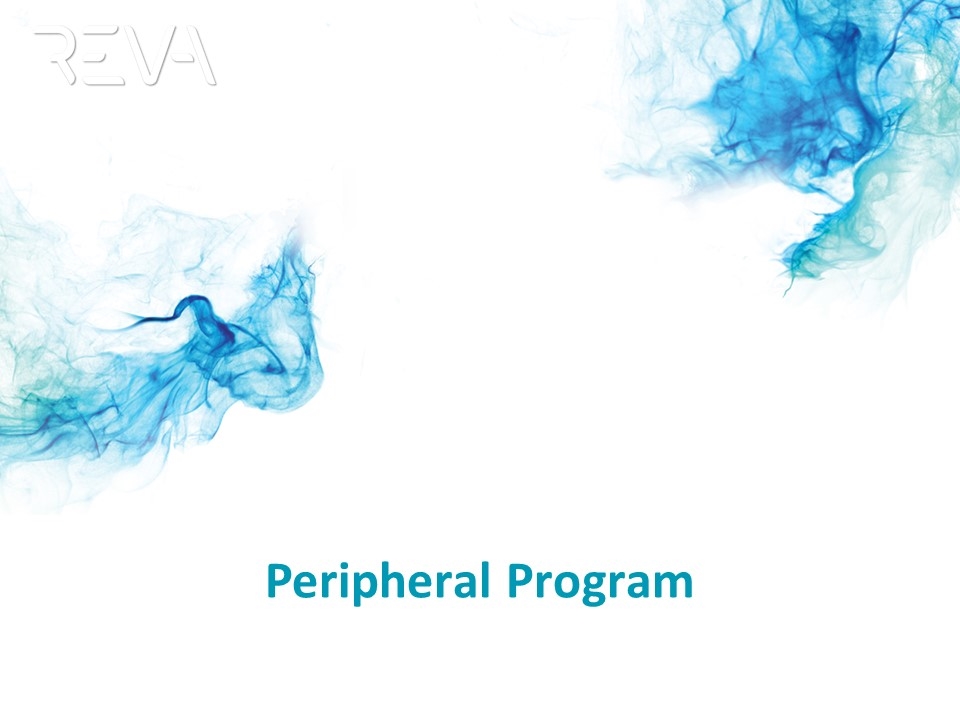
Peripheral Program
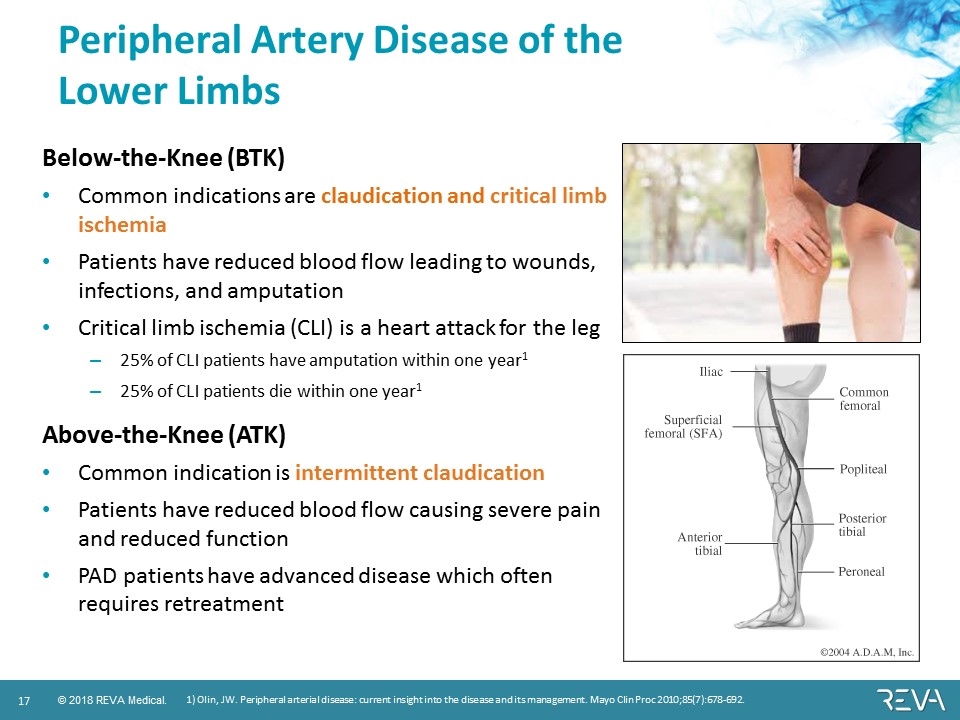
Peripheral Artery Disease of the Lower Limbs Below-the-Knee (BTK) Common indications are claudication and critical limb ischemia Patients have reduced blood flow leading to wounds, infections, and amputation Critical limb ischemia (CLI) is a heart attack for the leg 25% of CLI patients have amputation within one year1 25% of CLI patients die within one year1 Above-the-Knee (ATK) Common indication is intermittent claudication Patients have reduced blood flow causing severe pain and reduced function PAD patients have advanced disease which often requires retreatment 1) Olin, JW. Peripheral arterial disease: current insight into the disease and its management. Mayo Clin Proc 2010;85(7):678-692.
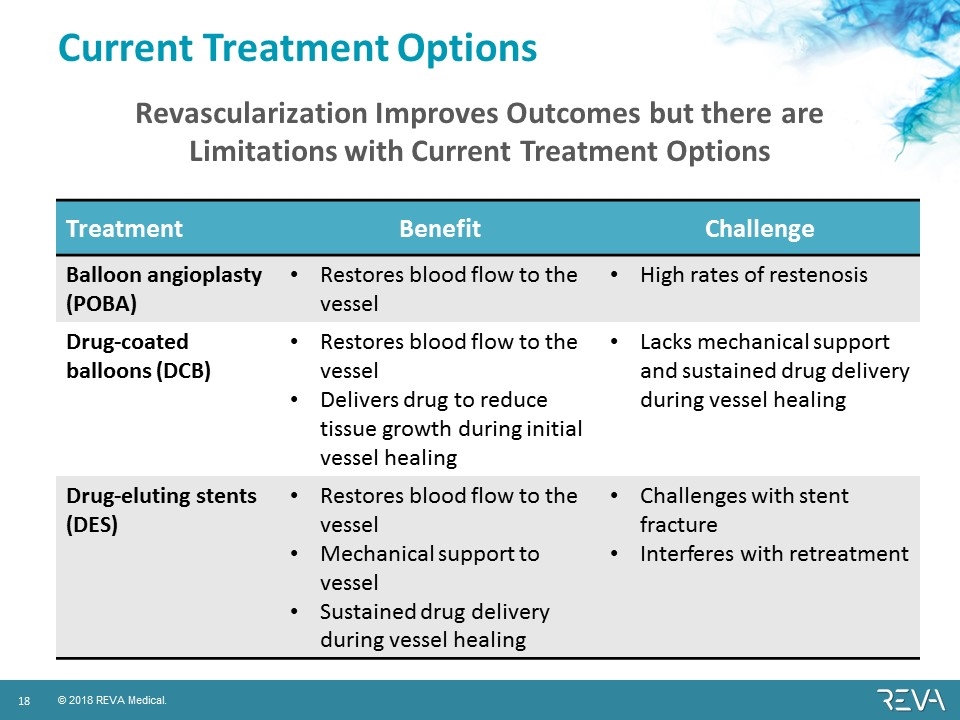
Current Treatment Options Treatment Benefit Challenge Balloon angioplasty (POBA) Restores blood flow to the vessel High rates of restenosis Drug-coated balloons (DCB) Restores blood flow to the vessel Delivers drug to reduce tissue growth during initial vessel healing Lacks mechanical support and sustained drug delivery during vessel healing Drug-eluting stents (DES) Restores blood flow to the vessel Mechanical support to vessel Sustained drug delivery during vessel healing Challenges with stent fracture Interferes with retreatment Revascularization Improves Outcomes but there are Limitations with Current Treatment Options
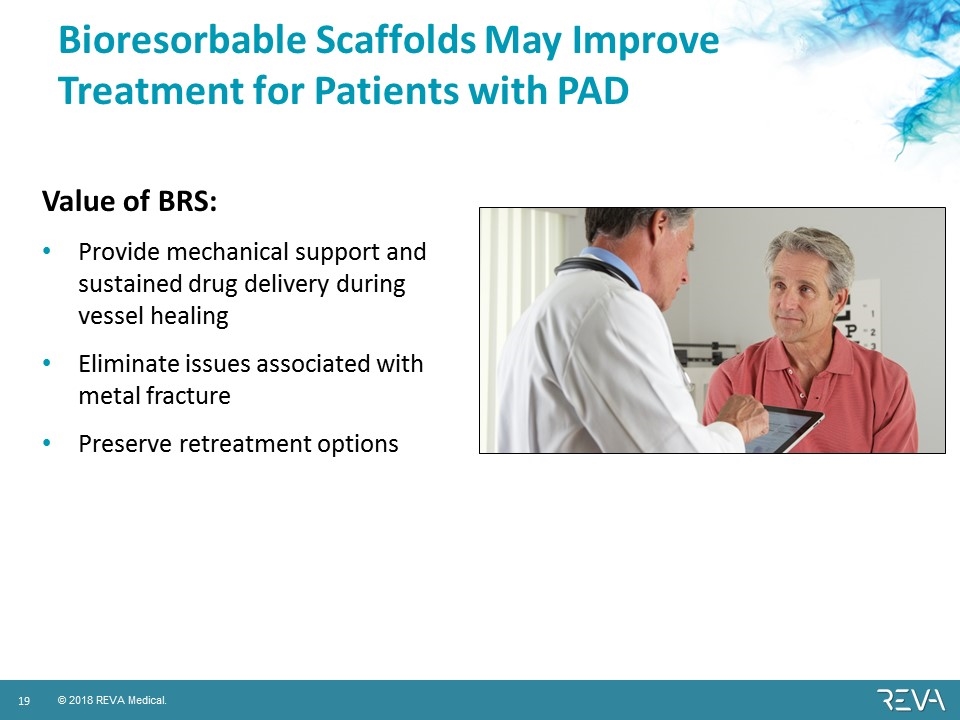
Bioresorbable Scaffolds May Improve Treatment for Patients with PAD Value of BRS: Provide mechanical support and sustained drug delivery during vessel healing Eliminate issues associated with metal fracture Preserve retreatment options
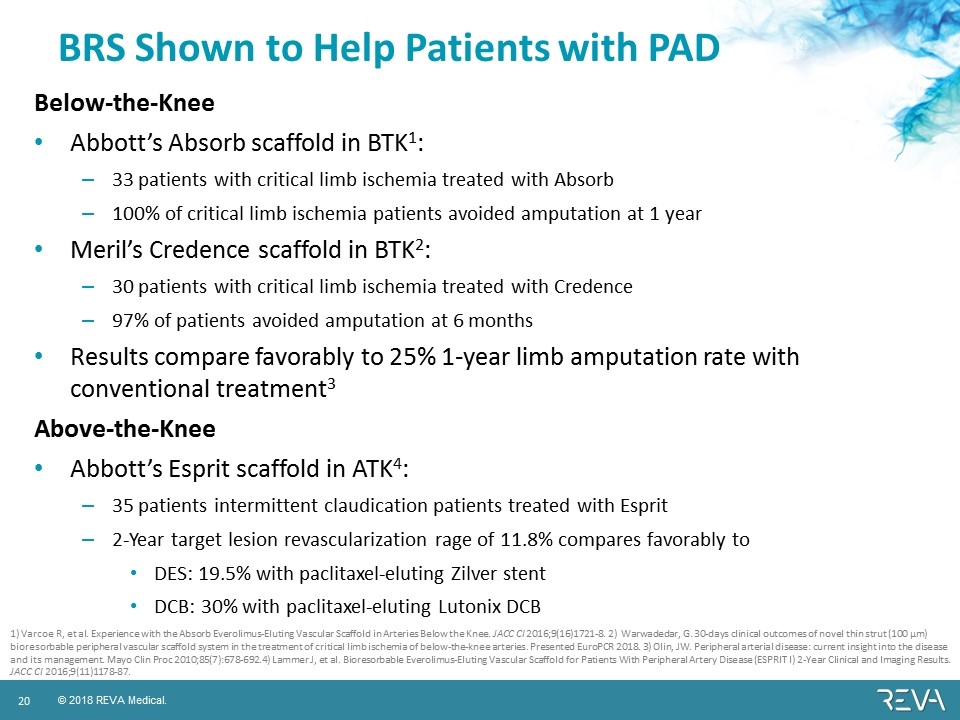
BRS Shown to Help Patients with PAD Below-the-Knee Abbott’s Absorb scaffold in BTK1: 33 patients with critical limb ischemia treated with Absorb 100% of critical limb ischemia patients avoided amputation at 1 year Meril’s Credence scaffold in BTK2: 30 patients with critical limb ischemia treated with Credence 97% of patients avoided amputation at 6 months Results compare favorably to 25% 1-year limb amputation rate with conventional treatment3 Above-the-Knee Abbott’s Esprit scaffold in ATK4: 35 patients intermittent claudication patients treated with Esprit 2-Year target lesion revascularization rage of 11.8% compares favorably to DES: 19.5% with paclitaxel-eluting Zilver stent DCB: 30% with paclitaxel-eluting Lutonix DCB 1) Varcoe R, et al. Experience with the Absorb Everolimus-Eluting Vascular Scaffold in Arteries Below the Knee. JACC CI 2016;9(16)1721-8. 2) Warwadedar, G. 30-days clinical outcomes of novel thin strut (100 µm) bioresorbable peripheral vascular scaffold system in the treatment of critical limb ischemia of below-the-knee arteries. Presented EuroPCR 2018. 3) Olin, JW. Peripheral arterial disease: current insight into the disease and its management. Mayo Clin Proc 2010;85(7):678-692.4) Lammer J, et al. Bioresorbable Everolimus-Eluting Vascular Scaffold for Patients With Peripheral Artery Disease (ESPRIT I) 2-Year Clinical and Imaging Results. JACC CI 2016;9(11)1178-87.
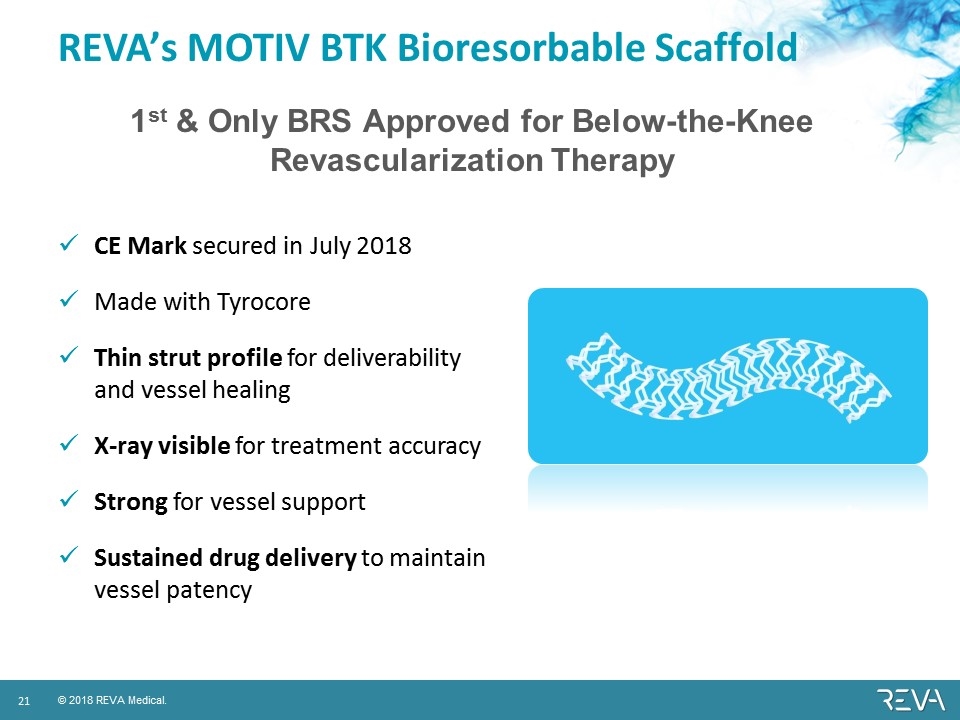
REVA’s MOTIV BTK Bioresorbable Scaffold CE Mark secured in July 2018 Made with Tyrocore Thin strut profile for deliverability and vessel healing X-ray visible for treatment accuracy Strong for vessel support Sustained drug delivery to maintain vessel patency 1st & Only BRS Approved for Below-the-Knee Revascularization Therapy
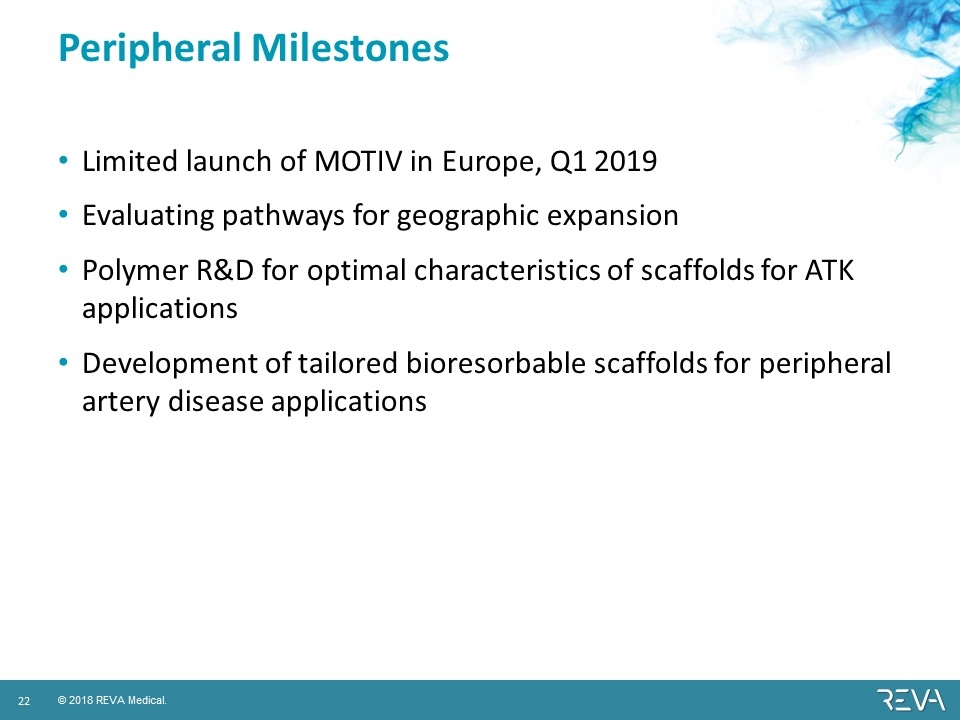
Limited launch of MOTIV in Europe, Q1 2019 Evaluating pathways for geographic expansion Polymer R&D for optimal characteristics of scaffolds for ATK applications Development of tailored bioresorbable scaffolds for peripheral artery disease applications Peripheral Milestones
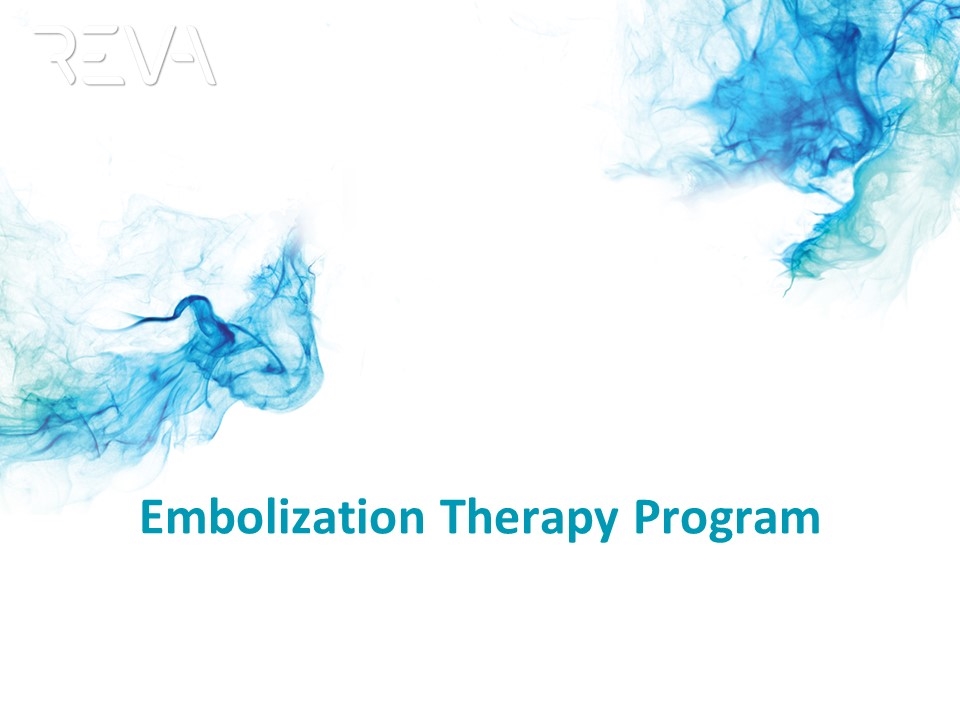
Embolization Therapy Program
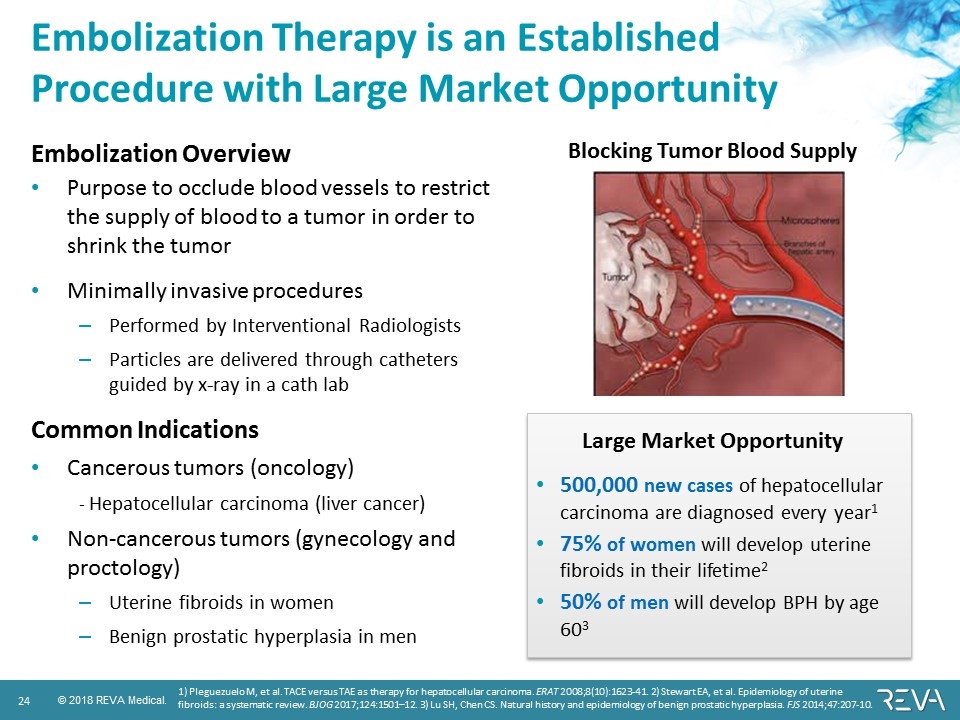
Embolization Therapy is an Established Procedure with Large Market Opportunity Embolization Overview Purpose to occlude blood vessels to restrict the supply of blood to a tumor in order to shrink the tumor Minimally invasive procedures Performed by Interventional Radiologists Particles are delivered through catheters guided by x-ray in a cath lab Common Indications Cancerous tumors (oncology) - Hepatocellular carcinoma (liver cancer) Non-cancerous tumors (gynecology and proctology) Uterine fibroids in women Benign prostatic hyperplasia in men Large Market Opportunity 1) Pleguezuelo M, et al. TACE versus TAE as therapy for hepatocellular carcinoma. ERAT 2008;8(10):1623-41. 2) Stewart EA, et al. Epidemiology of uterine fibroids: a systematic review. BJOG 2017;124:1501–12. 3) Lu SH, Chen CS. Natural history and epidemiology of benign prostatic hyperplasia. FJS 2014;47:207-10. 500,000 new cases of hepatocellular carcinoma are diagnosed every year1 75% of women will develop uterine fibroids in their lifetime2 50% of men will develop BPH by age 603 Blocking Tumor Blood Supply
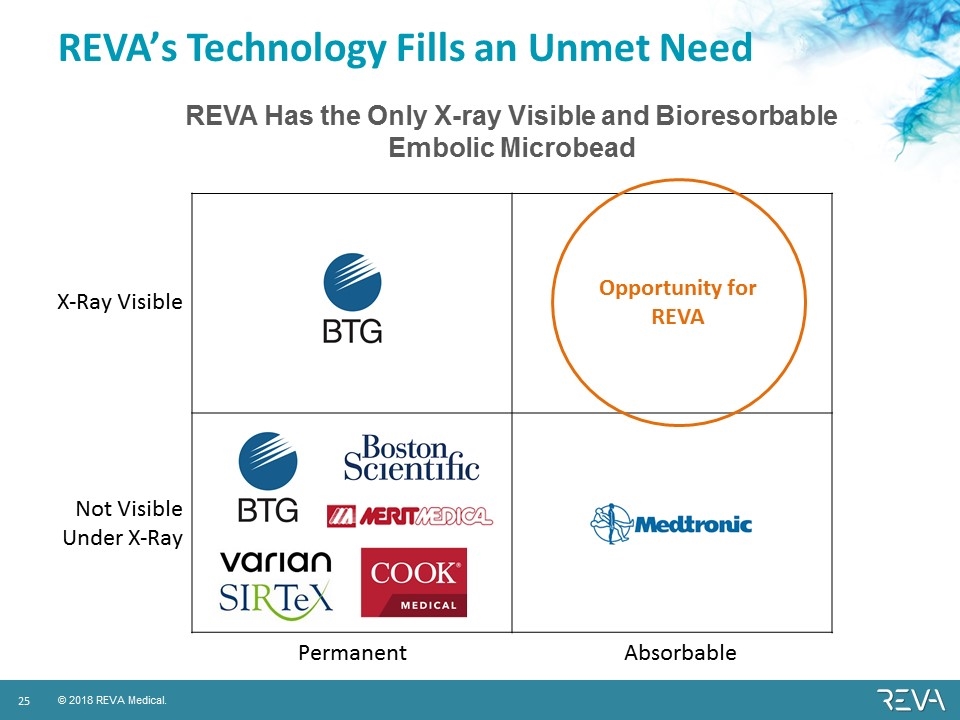
REVA’s Technology Fills an Unmet Need Not Visible Under X-Ray X-Ray Visible Permanent Absorbable Opportunity for REVA REVA Has the Only X-ray Visible and Bioresorbable Embolic Microbead
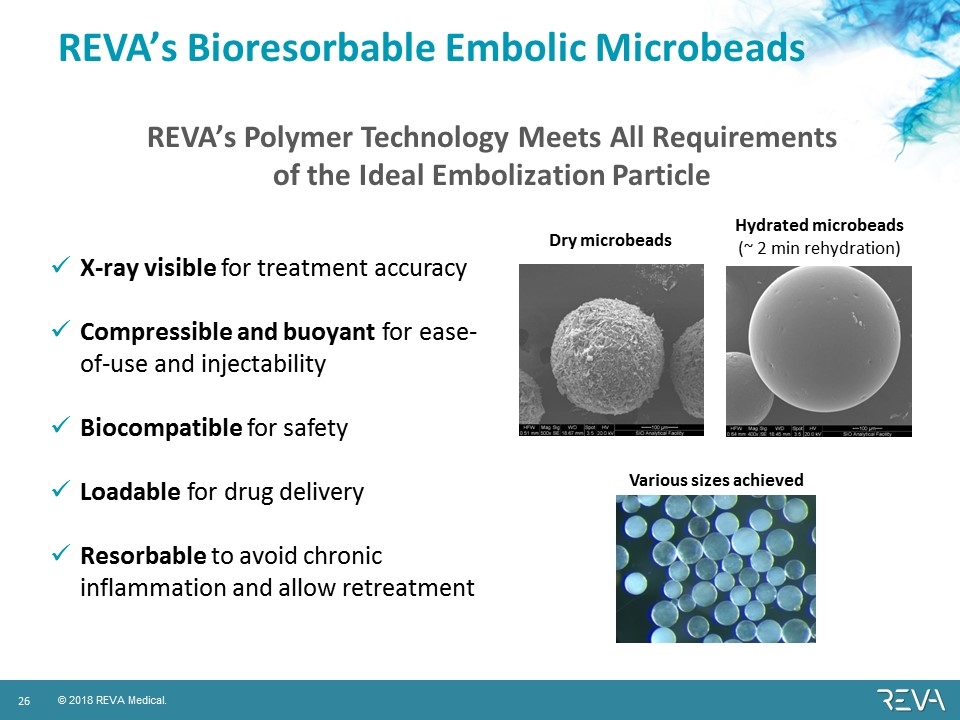
REVA’s Bioresorbable Embolic Microbeads X-ray visible for treatment accuracy Compressible and buoyant for ease-of-use and injectability Biocompatible for safety Loadable for drug delivery Resorbable to avoid chronic inflammation and allow retreatment REVA’s Polymer Technology Meets All Requirements of the Ideal Embolization Particle Dry microbeads Hydrated microbeads (~ 2 min rehydration) Various sizes achieved
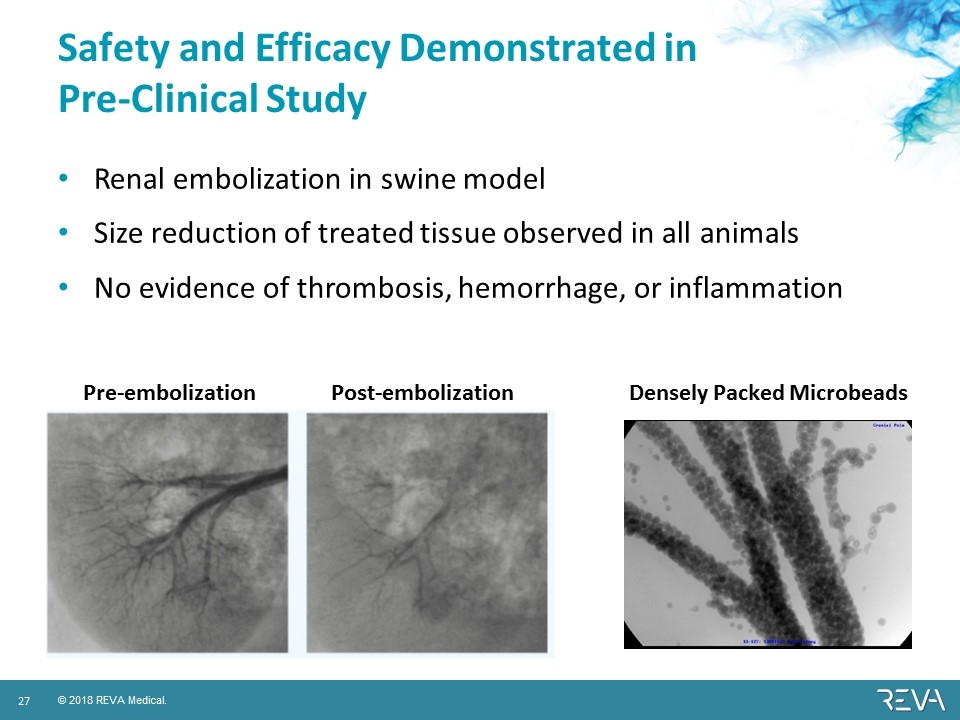
Safety and Efficacy Demonstrated in Pre-Clinical Study Renal embolization in swine model Size reduction of treated tissue observed in all animals No evidence of thrombosis, hemorrhage, or inflammation Pre-embolization Post-embolization Densely Packed Microbeads
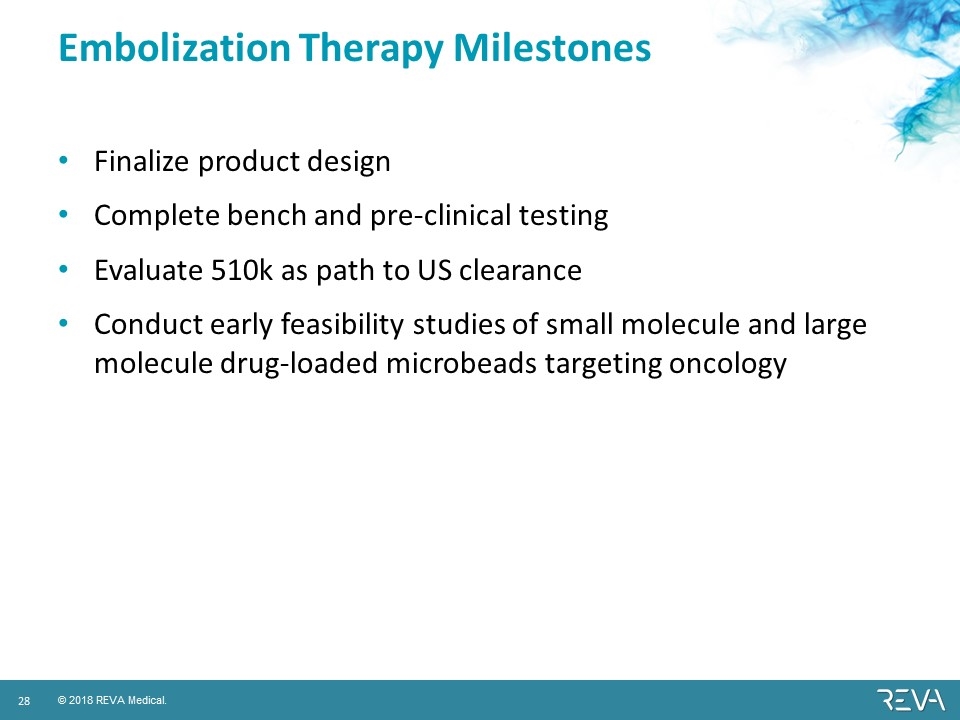
Finalize product design Complete bench and pre-clinical testing Evaluate 510k as path to US clearance Conduct early feasibility studies of small molecule and large molecule drug-loaded microbeads targeting oncology Embolization Therapy Milestones
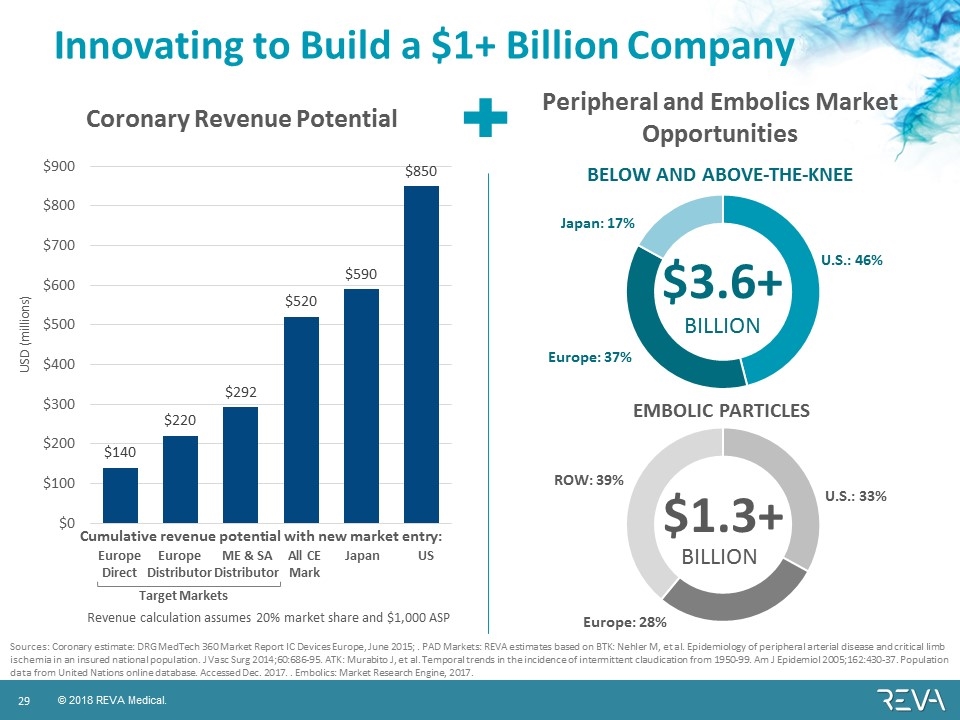
Innovating to Build a $1+ Billion Company Sources: Coronary estimate: DRG MedTech 360 Market Report IC Devices Europe, June 2015; . PAD Markets: REVA estimates based on BTK: Nehler M, et al. Epidemiology of peripheral arterial disease and critical limb ischemia in an insured national population. J Vasc Surg 2014;60:686-95. ATK: Murabito J, et al. Temporal trends in the incidence of intermittent claudication from 1950-99. Am J Epidemiol 2005;162:430-37. Population data from United Nations online database. Accessed Dec. 2017. . Embolics: Market Research Engine, 2017. Coronary Revenue Potential Peripheral and Embolics Market Opportunities $3.6+ BILLION Europe: 37% Japan: 17% U.S.: 46% BELOW AND ABOVE-THE-KNEE $1.3+ BILLION Europe: 28% ROW: 39% U.S.: 33% EMBOLIC PARTICLES Europe Distributor ME & SA Distributor All CE Mark Japan US Revenue calculation assumes 20% market share and $1,000 ASP Cumulative revenue potential with new market entry: Europe Direct Target Markets USD (millions)
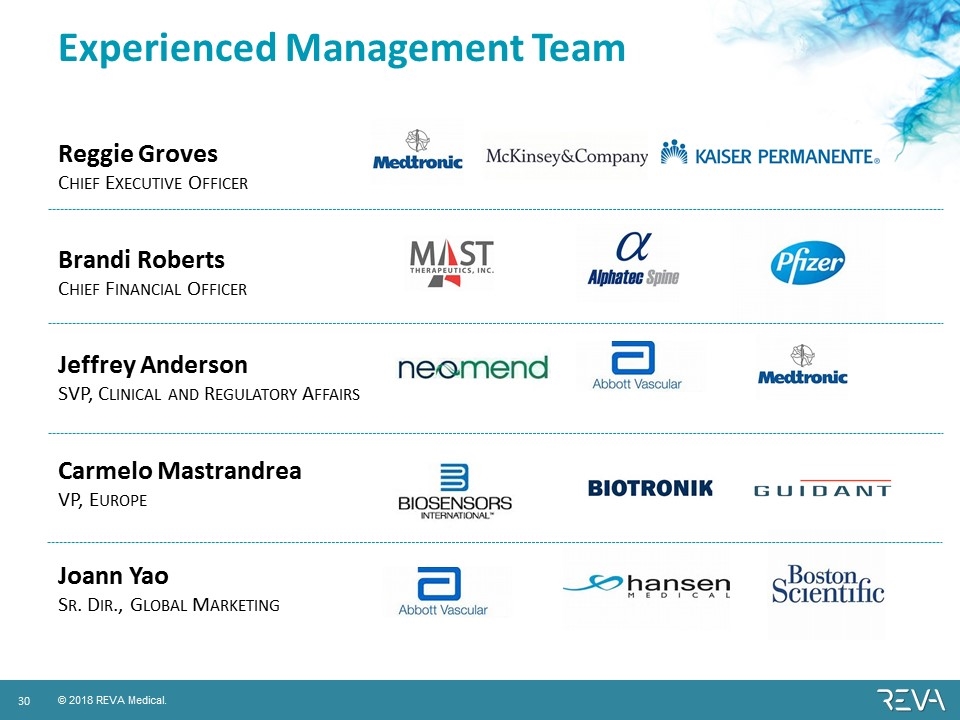
Experienced Management Team Reggie Groves Chief Executive Officer Brandi Roberts Chief Financial Officer Jeffrey Anderson SVP, Clinical and Regulatory Affairs Carmelo Mastrandrea VP, Europe Joann Yao Sr. Dir., Global Marketing
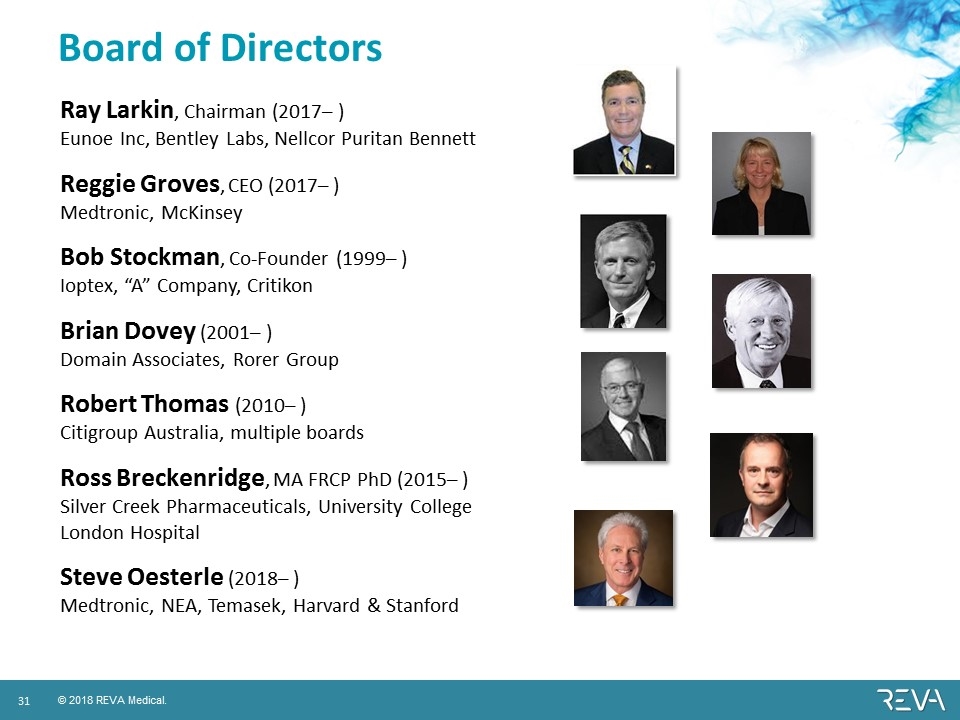
Board of Directors Ray Larkin, Chairman (2017– ) Eunoe Inc, Bentley Labs, Nellcor Puritan Bennett Reggie Groves, CEO (2017– ) Medtronic, McKinsey Bob Stockman, Co-Founder (1999– ) Ioptex, “A” Company, Critikon Brian Dovey (2001– ) Domain Associates, Rorer Group Robert Thomas (2010– ) Citigroup Australia, multiple boards Ross Breckenridge, MA FRCP PhD (2015– ) Silver Creek Pharmaceuticals, University College London Hospital Steve Oesterle (2018– ) Medtronic, NEA, Temasek, Harvard & Stanford
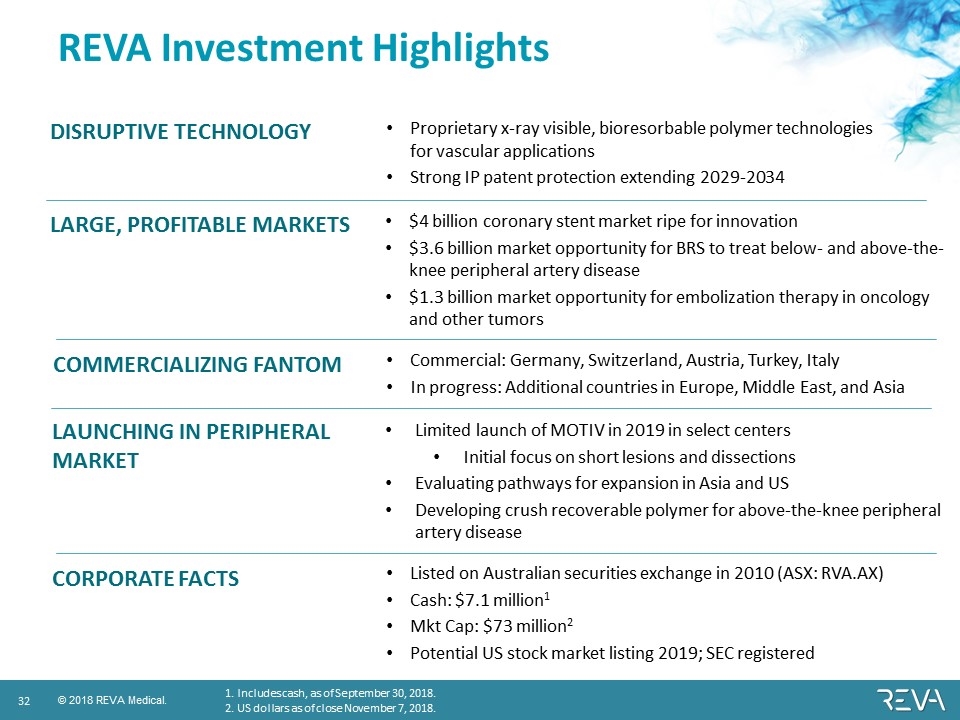
REVA Investment Highlights LARGE, PROFITABLE MARKETS DISRUPTIVE TECHNOLOGY Commercializing FANTOM LAUNCHING IN PERIPHERAL MARKET $4 billion coronary stent market ripe for innovation $3.6 billion market opportunity for BRS to treat below- and above-the-knee peripheral artery disease $1.3 billion market opportunity for embolization therapy in oncology and other tumors Proprietary x-ray visible, bioresorbable polymer technologies for vascular applications Strong IP patent protection extending 2029-2034 Commercial: Germany, Switzerland, Austria, Turkey, Italy In progress: Additional countries in Europe, Middle East, and Asia Limited launch of MOTIV in 2019 in select centers Initial focus on short lesions and dissections Evaluating pathways for expansion in Asia and US Developing crush recoverable polymer for above-the-knee peripheral artery disease CORPORATE FACTS Listed on Australian securities exchange in 2010 (ASX: RVA.AX) Cash: $7.1 million1 Mkt Cap: $73 million2 Potential US stock market listing 2019; SEC registered Includes cash, as of September 30, 2018. US dollars as of close November 7, 2018.
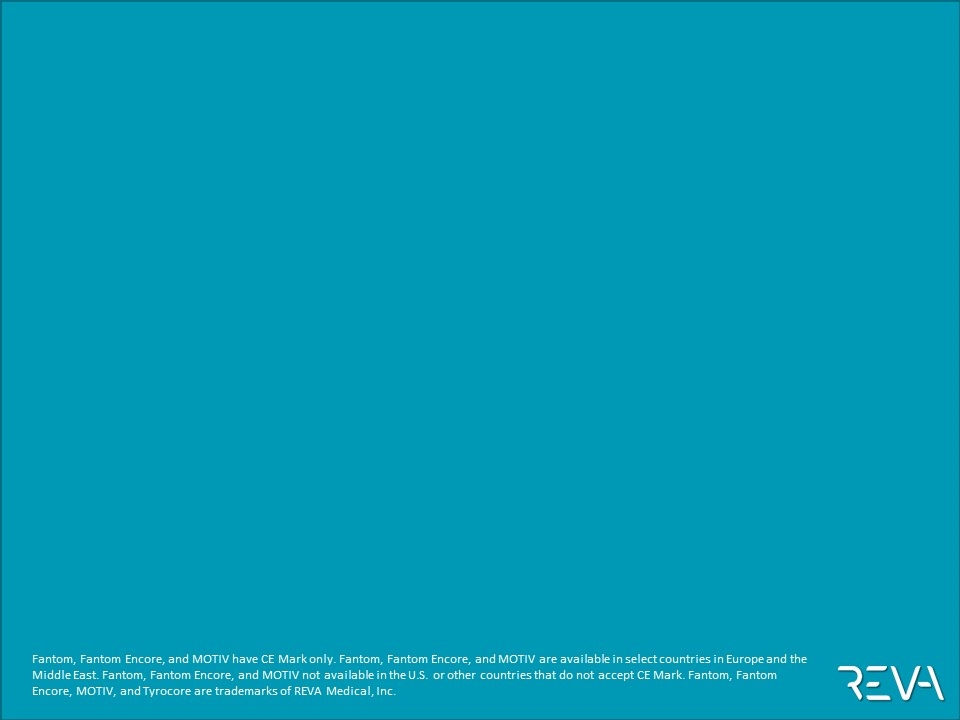
o Fantom, Fantom Encore, and MOTIV have CE Mark only. Fantom, Fantom Encore, and MOTIV are available in select countries in Europe and the Middle East. Fantom, Fantom Encore, and MOTIV not available in the U.S. or other countries that do not accept CE Mark. Fantom, Fantom Encore, MOTIV, and Tyrocore are trademarks of REVA Medical, Inc.

































